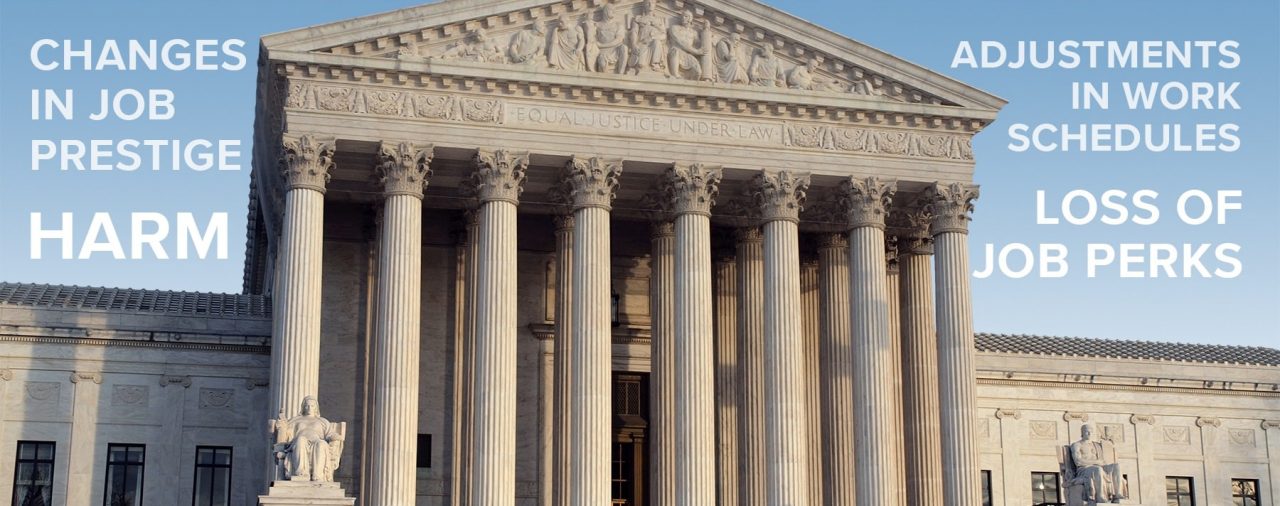Content Highlights
In Muldrow v. City of St. Louis, the US Supreme Court recently clarified the standard for proving harm caused by discrimination in claims under the Title VII of the Civil Rights Act. This decision affects workers at all levels, including executives. Discrimination can be subtle and will halt your career growth no matter your position.
Gardner Employment Law publishes articles to keep you up-to-date on landmark court decisions. Read on to learn about how to prove harm caused by discrimination.
How Did the SCOTUS Clarify What Evidence is Required to Show Harm Caused By Discrimination?
According to the new ruling, an employee challenging a discriminatory action must demonstrate that the adverse action caused “some” harm to an identifiable term or condition of employment. This is a significant shift from the previous caselaw, which required proof of a “significant” disadvantage resulting from the employer’s action.
This threshold of “some harm” simplifies the process for employees to litigate claims of discrimination. They no longer need to show that the harm incurred was substantial or materially significant. Instead, demonstrating harm related to their employment conditions or terms suffices. This change aims to ensure that Title VII can be asserted in a way to truly protect employees against discrimination based on sex, race, national origin, religion, age and disability.
Here is a summary of how the Muldrow opinion changed the law:
-
- Previous Standard: Required proof of “significant” harm, making it difficult for employees to succeed in claims without demonstrating substantial negative impact. Also, what is “significant” harm to one person may not be very significant to someone else in a different situation.
- New Standard: Requires showing only “some” harm, thus broadening the scope of what constitutes actionable discrimination under Title VII. The SCOTUS quoted directly from the statute which is designed to protect the “terms and conditions” of employment.
- Practical Impact: Employees can now base their claims on even subtle changes to their employment conditions. These could include changes such as loss of specific job perks, changes in job prestige, or adjustments in work schedules.
What Are the Facts in Muldrow v. City of St. Louis?
Sergeant Muldrow, a female peace officer employed by the St. Louis Police Department, alleged sex discrimination because the city transferred her from her position in the Intelligence Division to a uniformed patrol role. Although her rank and pay remained unchanged, the new position came with less prestige, fewer perks, and a more demanding schedule. Being out on patrol was a more difficult job. Sgt. Muldrow argued that these changes constituted an adverse employment action based on sex discrimination.
The lower courts initially ruled against Sgt. Muldrow, stating that she had not demonstrated a “materially significant disadvantage” as a result of her transfer. However, the Supreme Court found that the lower courts applied the wrong standard. The Court ruled unanimously that proving “some” harm to an identifiable term or condition of employment is sufficient for a Title VII claim. This decision underscores that even minor changes in job conditions, if discriminatory, can be grounds for a legal challenge.
- Original Role: Sgt. Muldrow worked in the prestigious Intelligence Division with perks such as plain clothes work, a strict Monday-to-Friday schedule, and access to an unmarked FBI vehicle.
- Transferred Role: The city moved her to a uniformed patrol position with a more administrative focus, less prestige, and an irregular schedule that included weekend work.
- Court’s Reasoning: The Court emphasized that any harm to an employee’s terms or conditions of employment due to discriminatory reasons is actionable, regardless of the magnitude of harm.
What Are The Future Implications in Cases Alleging Harm Caused by Discrimination?
The Supreme Court’s decision in the Muldrow case has far-reaching implications for future discrimination claims. By lowering the bar for proving harm, the ruling likely will cause an increase in the number of successful claims under Title VII. Employees now have a broader scope to demonstrate how discriminatory actions have affected their employment terms or conditions, even if the changes are not significantly detrimental.
The decision takes into account that harms exist which, though difficult to discern by an outsider, the persons involved know that the employer placed the employee in a less desirable situation. Others outside the protected class, in this case male officers, enjoy a better situation. The act itself demonstrated that the city view Sgt. Muldrow’s value as less than. And that is the essence of discrimination.
This decision places a greater responsibility on employers to ensure that all personnel choices are fair and free from discriminatory motives. Employers must review and possibly revise their policies and practices to comply with anti-discrimination laws more stringently. Training for managers and supervisors should be updated to reflect the new standard, emphasizing the importance of non-discriminatory decision-making in all aspects of employment.
Future cases are required to consider what constitutes “some” harm and refine the application of this new standard. Employees should remain vigilant and informed about these developments to navigate the evolving landscape of employment discrimination law effectively.
Contact An Expert.
The Supreme Court’s ruling in Muldrow lowered the bar for proving harm. This change enhances protections for employees and imposes stricter compliance requirements on employers, shaping the future of workplace discrimination litigation. If you need help understanding how these changes might affect you, contact us today.

